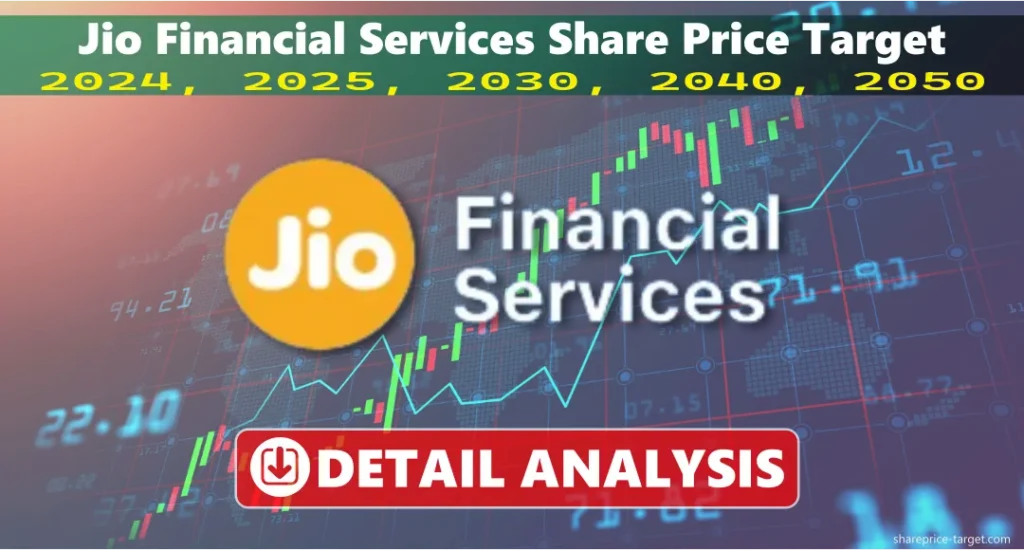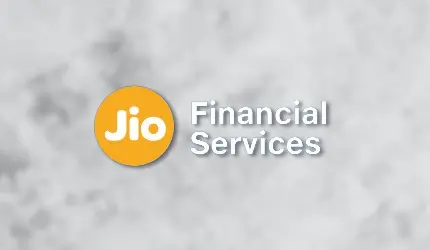Jio Financial Services Share Price Target 2025, 2026, 2030, 2040, 2050
Since its August 2023 listing on the Indian stock markets, Jio Financial Services, previously Reliance Industries (RIL), has become a major financial player in India.
Jio Financial Services attracts investors with its financial services, payment solutions, and insurance brokerage. Jio Financial Services share price predictions for 2024, 2025, 2030, 2040, and 2050 are thoroughly examined in this article.
- 1 What is Jio Financial Services Ltd NSE: JIOFIN?
- 2 Jio Financial Services share price Target
- 3 Jio Financial Services share price Target 2025
- 4 Jio Financial Services share price Target 2026
- 5 Share price Target 2027
- 6 Share price Target 2028
- 7 Share price Target 2029
- 8 Jio Financial Services share price Target 2030
- 9 Share price Target 2040
- 10 Share price Target 2050
- 11 Should I buy Jio Financial Services stock?
- 12 Jio Financial Services earning results
- 13 Expert forecasts on the future of Jio Financial Services
- 14 Is Jio Financial Services stock good to buy? (bull case & bear case)
- 15 Conclusion
- 16 FAQs
What is Jio Financial Services Ltd NSE: JIOFIN?
Famous Mumbai-based financial services business Jio Financial Services is listed on the National Stock Exchange (NSE) as JIOFIN. Mukesh Ambani founded the firm to provide payment solutions and insurance brokerage to Indian clients. K. V. Kamath and Rajiv Mehrishi lead Jio Financial Services’ brokerage and clearing activities under rigorous regulatory constraints.
The company is supported by the huge Reliance Industries group and is in a very strong position to grow. The company benefits from the large network of Reliance, especially through its telecom business, Jio, which already has millions of customers. With the growth of digital financial services, its services can easily reach this vast customer base and provide them with various financial products. The company’s strength lies in its advanced technology and access to a lot of data, which will help it offer better services to customers. In 2025, its share price target would be ₹470, as per our analysis.
By our prediction, its share price will be between ₹157 and ₹470 in 2025.
The company is planning to get more money to grow its business. The Ambani family wants to invest ₹2.1 lakh crore to own more than 51% of the company. The company’s board is thinking about different ways to raise this money. They want to use it to grow in areas like digital finance and lending. Recently, the company made 3.8% more profit in the first quarter of the financial year 2026. Since March, the company’s share price has gone up by 60%. Experts feel more positive about the company now, and many people are waiting to see what decisions will be made in the upcoming board meeting.
| Year | Minimum Price (Rs) | Maximum Price (Rs) |
| 2025 | 157 | 470 |
| Month | Minimum Price (Rs) | Maximum Price (Rs) |
| January | 225 | 310 |
| February | 204 | 257 |
| March | 188 | 280 |
| April | 180 | 290 |
| May | 200 | 330 |
| June | 157 | 360 |
| July | 306 | 335 |
| August | 224 | 377 |
| September | 235 | 390 |
| October | 274 | 425 |
| November | 265 | 458 |
| December | 300 | 470 |
JIO Stock Recommendation
| Buy | Sell | Hold |
| 0% | 100% | 0% |
With the strong support of Reliance’s retail and telecom businesses, it will be able to offer its financial services to an even larger customer base. The company’s use of technology and data will allow it to understand customer needs more effectively and improve their services. These strengths, combined with the ability to offer products that appeal to a wide range of people, will help the company grow and could result in a higher share price. In 2026, its share price target would be ₹533, as per our prediction.
Its share price would be between ₹270 and ₹533 in 2026, as per our analysis.
| Year | Minimum Price (Rs) | Maximum Price (Rs) |
| 2026 | 270 | 533 |
| Month | Minimum Price (Rs) | Maximum Price (Rs) |
| January | 300 | 478 |
| February | 318 | 347 |
| March | 270 | 300 |
| April | 287 | 343 |
| May | 300 | 374 |
| June | 328 | 390 |
| July | 365 | 410 |
| August | 378 | 438 |
| September | 390 | 458 |
| October | 421 | 470 |
| November | 454 | 490 |
| December | 470 | 533 |
The company focus on offering more digital financial products and services. With the support of Reliance Industries, it can serve a growing customer base that trusts the brand. It uses technology to improve how it serves its customers. This includes offering more personalized services using data analysis, as well as exploring new technologies like artificial intelligence and blockchain. These strengths, along with the company’s reputation and large customer base, will help it perform well in the stock market. In 2027, its share price target would be ₹652, as per our analysis.
By our prediction, its share price will be between ₹315 and ₹652 in 2027.
| Year | Minimum Price (Rs) | Maximum Price (Rs) |
| 2027 | 315 | 652 |
| Month | Minimum Price (Rs) | Maximum Price (Rs) |
| January | 470 | 547 |
| February | 427 | 500 |
| March | 370 | 420 |
| April | 315 | 346 |
| May | 329 | 378 |
| June | 357 | 390 |
| July | 378 | 420 |
| August | 390 | 441 |
| September | 328 | 467 |
| October | 420 | 522 |
| November | 487 | 610 |
| December | 578 | 652 |
The company uses its strong technology and data capabilities to offer a wide range of financial products that meet the needs of Indian consumers. Jio Financial Services creates secure and efficient services to help grow, especially in a country where more people are moving toward digital financial solutions. The company’s connection to Reliance Industries also gives it a strong reputation and the ability to reach more customers, further boosting its growth potential. In 2028, its share price target would be ₹777, as per our prediction.
Its share price would be between ₹440 and ₹777 in 2028, as per our analysis.
| Year | Minimum Price (Rs) | Maximum Price (Rs) |
| 2028 | 440 | 777 |
| Month | Minimum Price (Rs) | Maximum Price (Rs) |
| January | 578 | 667 |
| February | 534 | 610 |
| March | 488 | 510 |
| April | 440 | 470 |
| May | 461 | 497 |
| June | 478 | 530 |
| July | 490 | 561 |
| August | 525 | 578 |
| September | 555 | 590 |
| October | 571 | 630 |
| November | 600 | 690 |
| December | 670 | 777 |
The company’s strengths come from offering a full range of services, such as loans, insurance, and wealth management. Its services use its deep understanding of the Indian market and its technological expertise to provide products that meet the needs of all kinds of customers. The company’s ability to reach rural areas, where financial services have not always been easily available, will also contribute to its growth. These strengths help it to gain more customers. In 2029, its share price target would be ₹900, as per our analysis.
By our prediction, its share price will be between ₹550 and ₹900 in 2029.
| Year | Minimum Price (Rs) | Maximum Price (Rs) |
| 2029 | 550 | 900 |
| Month | Minimum Price (Rs) | Maximum Price (Rs) |
| January | 670 | 789 |
| February | 624 | 700 |
| March | 590 | 670 |
| April | 550 | 658 |
| May | 587 | 688 |
| June | 627 | 721 |
| July | 658 | 774 |
| August | 710 | 800 |
| September | 741 | 829 |
| October | 768 | 841 |
| November | 810 | 872 |
| December | 856 | 900 |
Its connection to Reliance Industries continues to give it an edge, as it strengthens other businesses to offer customers more value. The company’s focus on technology, such as artificial intelligence, will also help it provide personalized financial solutions to customers. These strengths will help the company continue to grow and perform well in the stock market. In 2030, its share price target would be ₹1048, as per our prediction.
Its share price would be between ₹673 and ₹1048 in 2030, as per our analysis.
| Year | Minimum Price (Rs) | Maximum Price (Rs) |
| 2030 | 673 | 1048 |
| Month | Minimum Price (Rs) | Maximum Price (Rs) |
| January | 856 | 911 |
| February | 810 | 871 |
| March | 758 | 788 |
| April | 731 | 781 |
| May | 673 | 720 |
| June | 690 | 739 |
| July | 718 | 780 |
| August | 756 | 810 |
| September | 784 | 856 |
| October | 828 | 990 |
| November | 870 | 1012 |
| December | 889 | 1048 |
It is a major player in the global financial services market. The company’s strength comes from its long-term focus on using technology and innovation to meet the needs of its customers. It continues to expand, benefiting from its strong foundation in India as well as its growing presence in international markets. The company’s expertise in areas like digital payments and lending will make it well-positioned to take advantage of future trends in the financial industry. These strengths help the company continue to grow and will likely lead to a steady increase in its share price. In 2040, its share price target would be ₹2156, as per our analysis.
By our prediction, its share price would be between ₹1790 and ₹2156 in 2040.
| Year | Minimum Price (Rs) | Maximum Price (Rs) |
| 2040 | 1790 | 2156 |
| Month | Minimum Price (Rs) | Maximum Price (Rs) |
| January | 1790 | 1838 |
| February | 1800 | 1857 |
| March | 1834 | 1871 |
| April | 1854 | 1890 |
| May | 1868 | 1920 |
| June | 1890 | 1948 |
| July | 1920 | 1974 |
| August | 1947 | 2000 |
| September | 1978 | 2026 |
| October | 2041 | 2068 |
| November | 2051 | 2090 |
| December | 2072 | 2156 |
It is expected to be a leading force in the global financial services industry. It going to soon offer a wide range of solutions, including banking, insurance, investment management, and more, all powered by advanced technology. Its connection to Reliance Industries will continue to help it grow and reach more customers. These advantages will ensure the company remains a leader in the financial services sector and help drive steady growth in its share price over the long term. In 2050, its share price target would be ₹3450, as per our prediction.
Its share price would be between ₹3019 and ₹3450 in 2050, as per our analysis.
| Year | Minimum Price (Rs) | Maximum Price (Rs) |
| 2050 | 3019 | 3450 |
| Month | Minimum Price (Rs) | Maximum Price (Rs) |
| January | 3019 | 3070 |
| February | 3028 | 3097 |
| March | 3058 | 3100 |
| April | 3080 | 3129 |
| May | 3100 | 3157 |
| June | 3130 | 3180 |
| July | 3157 | 3228 |
| August | 3180 | 3258 |
| September | 3210 | 3280 |
| October | 3247 | 3328 |
| November | 3287 | 3390 |
| December | 3357 | 3450 |
Should I buy Jio Financial Services stock?
| Year | Minimum Price (Rs) | Maximum Price (Rs) |
| 2025 | 157 | 470 |
| 2026 | 270 | 533 |
| 2027 | 315 | 652 |
| 2028 | 440 | 777 |
| 2029 | 550 | 900 |
| 2030 | 673 | 1048 |
| 2040 | 1790 | 2156 |
| 2050 | 3019 | 3450 |
Jio Financial Services stock investors must examine several aspects that might affect the company’s performance and share price. This includes:
- Jio Financial Services’ new financial products, smart collaborations, and growing client base should fuel growth.
- Jio Financial Services benefits from the digitalization of financial services and the need for quick and accessible banking solutions.
- Indian financial enterprises like Jio Financial Services may gain from economic expansion.
- Investors should consider regulatory changes, competitive challenges, technology upheavals, and macroeconomic concerns.
- Investors must investigate and contact financial specialists before investing.
Jio Financial Services earning results
| Mar 2023 | Mar 2024 | TTM | |
| Sales + | 45 | 1,855 | 1,968 |
| Expenses + | 6 | 296 | 437 |
| Operating Profit | 39 | 1,559 | 1,531 |
| OPM % | 88% | 84% | 78% |
| Other Income + | 10 | 429 | 435 |
| Interest | 0 | 10 | 0 |
| Depreciation | 0 | 22 | 22 |
| Profit before tax | 49 | 1,956 | 1,944 |
| Tax % | 37% | 18% | |
| Net Profit + | 31 | 1,605 | 1,607 |
| EPS in Rs | 2.53 | 2.52 | |
| Dividend Payout % | 0% | 0% |
Expert forecasts on the future of Jio Financial Services
Industry professionals and analysts like Jio Financial Services’ potential. Reasons for optimism include the high development potential of the Indian financial services business, where just 2% of the population invests in financial assets and 7% in mutual funds.
- Increased financial knowledge, technology, and investment opportunities boost market involvement.
- Jio Financial Services plans to capitalize on these developments with new products and services.
- Analysts also see the company’s profitability, EPS growth, and ROE as promising.
Is Jio Financial Services stock good to buy? (bull case & bear case)

Bull case
- Indian financial services have high development potential.
- Innovative financial products and smart collaborations boost growth.
- Market dynamics and economic prospects favour corporate growth.
- Strong earnings and balance sheet.
Bear case
- Possible banking industry regulation and competition.
- Technological upheavals and macroeconomic uncertainty threaten firm performance.
- Its 7.00 P/B ratio may imply overvaluation.
Conclusion
Jio Financial Services, a major participant in the Indian financial services business, emphasizes innovation, strategic partnerships, and customer service. The company’s share price projections for 2024, 2025, 2030, 2040, and 2050 reflect its growth potential and India’s favorable market circumstances.
Before investing, investors should analyze the company’s financial performance, market trends, economic prospects, and dangers. Research and professional assistance are needed to match investing strategies to financial objectives and risk tolerance.








